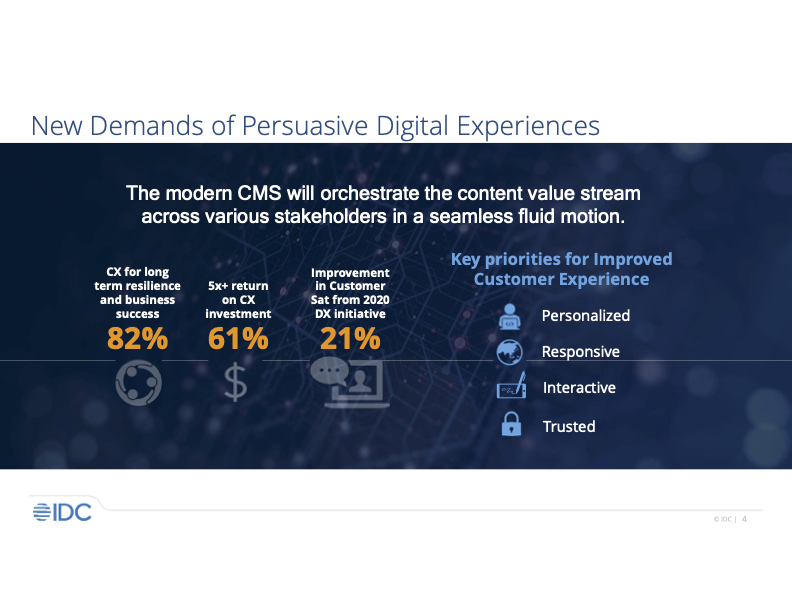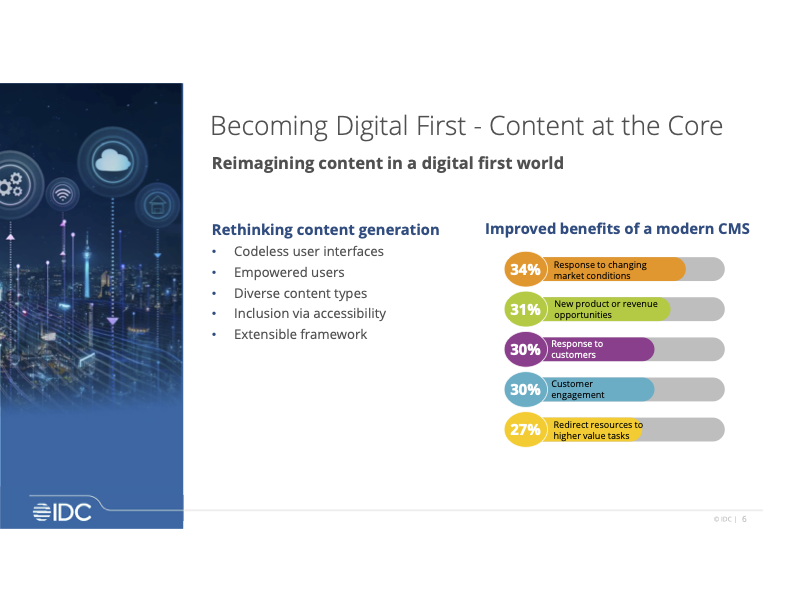Using a Modern CMS to Build Persuasive Digital Experiences | Webinar Recap

WordPress VIP CEO Nick Gernert sat down with IDC Research Director Marci Maddox during our recent webinar to discuss how a modern CMS can build not just engaging digital experiences but persuasive digital experiences for customers.
From handling the increased demand for content velocity to improving the customer experience to build trust, we’ve distilled conversation highlights—grouped by the key discussion topics our presenters covered.
Digital transformation is driving an evolution in customer experiences
Marci:
For a long time, customer experience and customer engagement has been top of mind for many organizations. It’s been their board level discussions, it’s been their competitive strategy. And then we hit the pandemic, and things got shaken up.
In early 2020, we noted that cloud, security, and remote work were all top of mind for those organizations. But by about mid-year, we saw that the customer experience was really back out in front. Unfortunately, as the world was on lockdown, a lot of websites failed both the businesses and the consumers in that regard.
We saw online traffic spiking such that 40% of organizations said that they had significantly high to almost outage-level demands. And with the cloud being available, about a third of businesses were looking to either replace some antiquated CMS or add new sites.
In many ways, organizations who had never considered being an online retailer before were now thrown into this digital world. But it wasn’t just technology that changed during the past 18 months, there was also a human element, too.
In fact, IDC has done recent research that baby boomers are now fueling the increase in B2B online commerce, almost to the level of the usage of Gen Zers. That means they’re not looking to interface with human salespeople anymore but rather through the digital channel.
Last year when we surveyed them, they were looking to use online commerce 49% of the time. Today, it’s up to 64%. That’s a 15-point increase in just a year.

Handling the increased demand for content velocity
Marci:
This digital transformation that’s been happening has placed a huge demand on content creators, because they’re trying to get more content into the hands of their customers, their partners, their constituents—all these audiences.
What we found in our surveys was that some of the biggest challenges were about the amount of time it takes an idea to get on paper and out to the website, to the mobile device. Many organizations are still depending on IT to do that last mile publication to get things live.
One thing we’re talking about today is content velocity. How do we handle it? How do we create content and democratize content creation? And what does that mean to organizations?
When we ask organizations where this is going to take them in the future, many said they expected a 26% increase in the number of content authors they are going to add to their staff over the next two years.
Nick:
This 26% increase feels about right in terms of what we’re seeing. Organizations are driving towards putting simpler, easier-to-use tools in the hands of more folks to create these touch points with their customers.
What’s really critical to this from my perspective is creating feedback loops as you do that. As you increase this velocity and as you start putting more out into the market, there’s also a greater emphasis on deeply understanding what is and what is not working. And being able to focus on where you’re seeing success and tighten those feedback loops.

The ROI on improving customer experience
Marci:
During the pandemic, we saw many organizations that had their website as their front face to their consumers. The consumers were looking at their favorite brands with highly personalized, interconnected, and empathetic connections, trying to move that physical into a digital space. This puts pressure on content authors to find new ways to connect.
We did a survey where that found 82% of organizations are prioritizing customer experience for long term resilience and success. That’s because 61% of organizations have seen at least a 5x return on every dollar they put in improving customer experience.

If you correlate that to the larger digital transformation, which is everything from technology changes to process changes across the board, remote work and handling IT for accessibility, that percent was a 21% improvement in customer satisfaction as an annual return rate.
These are not small numbers. These are great experiences coming back to you in the form of profit, closed transactions, and better funnel conversions.
Every time that you use, for example, a product description, a video, or a customer story that you’ve created for your product, all those things add value to the overall experience and the journey your customers are going through.
How improving customer experience ties into building trust
Nick:
Trust is also a pretty big concept and something, from a consumer perspective, in short supply. What advice do you have for folks if trust is one of those key priorities? What are the ways that folks are being successful in that area?
Marci:
We’ve seen a change from third-party cookie data moving to first-party data. So you need to start to think: what’s going to make me as a consumer give up this information?
Am I going to get back an experience that’s tailored to me? Or are you going to abuse my information or not have it secured in a system? And then we start talking about data residency across different countries. Many organizations that want to have a global presence need to recognize the local laws and how things are going to be managed.
That comes down to an architectural and technical capability to handle data residency problems and challenges with regulations. Data trust is becoming personal. It’s about building trust with a brand.
The importance of accessibility and simplicity in a modern CMS
Marci:
Instead of relying on a single monolithic application, brands are looking to move to the cloud and use best-of-breed capabilities to meet the focus of a specific task. The cloud in particular has been that opportunity to expand quickly and at scale.
We’re about to head into the holiday season. If you’re a marketer and preparing for Black Friday or Cyber Monday, you want to have all of these promotions and great content to help sell your products then. But what if your CMS can’t publish the information in time or your IT team isn’t available until the following Tuesday? You’ll miss a window of opportunity that won’t come around for another year.
Timing is important. The cloud allows you to scale and automate repetitive tasks while letting creative teams do what they do best.

Nick:
There are many things we do personally that technology makes satisfying, streamlined, quick, efficient, empowering, simple, and easy to use. There’s no reason that shouldn’t carry that into the tools we use in our day-to-day work lives.
As we’re talking about content production at scale, we need to remember that simplicity scales. We can actually put more tools [like modern CMSes] in the hands of content creators if they’re intuitive and if they’re actually enjoyable to use.
Marci:
A lot of work goes into building out a system behind the scenes that makes the front end simple and easy to use, easy to deploy, easy to scale. But under the covers, and as I’ve seen with WordPress VIP, you need to put much time and effort into making sure that happens. So that people can sit down and start publishing content on day one.
It goes back to that trust in the tool that it’s going to do exactly what I want it to do and guarantee delivery.
Content creation and publication in the future
Marci:
You’re not putting a CMS in place just for today’s activities, you’re also putting it in place for longterm resiliency and driving customer satisfaction. So as we look to the future, we need to think about things like non-fungible tokens, NFTs, and validating video—making sure they’re authentic. Some of the same concepts that have been in legal documents for decades are now moving into our digital experiences.
We also need to think about generational gaps that are shrinking in this digital environment. As marketers, you’re going to need to look at how to address those baby boomers, while at the same time trying to address Gen Zers. There might be a new audience that’s now beginning to be more pervasive in your customer experience considerations.
We also need to ensure that your tools are actually making it easier for you to do this. In fact, IDC learned that 85% of organizations found that improving the employee experience and making them more engaged drove better customer satisfaction, better customer experiences.
Nick:
There’s also a big push towards shifting organizations to be able to adapt to unexpected things more quickly. And a lot of that does come from the foundation, things like content platforms. The richness in APIs and the interoperability of systems now actually opens up the opportunity to have multiple platforms really coming together and starting to chip away at the problem.
With the interoperability of a modern CMS and content analytics, it’s becoming easier to understand what is or is not working. We’ve seen organizations like HelloFresh start deeply looking at the results of their content production and increase overall traffic by 60% by focusing on what was or was not resonating in what they were creating.
Final words
Marci:
WordPress is well known in the market. It’s a trusted brand that really built out that underpinning to make it easier and simpler to create content.
You can take this in any direction that you want, the sky’s the limit. Just build on that flywheel and get those tools underneath you to help you handle the content velocity as we move into the future, because it’s not stopping anytime soon.
Nick:
I want to encourage folks to think beyond the technology aspect and to the people part of this, which is both internal as well as external. What does this do for our customer? What does this do for us as a business?
We need to take a step back from the technology as a whole and start by making people the sole focus of digital transformation. That’s why we’ll need human-centric software to get us there.
Next steps
Check out the full webinar replay for Nick and Marci’s complete discussion on using a modern CMS to build persuasive digital experiences. Then learn why WordPress VIP was named a leader in the 2021 IDC MarketScape Worldwide Content Management Systems for Persuasive Digital Experiences Vendor Assessment.